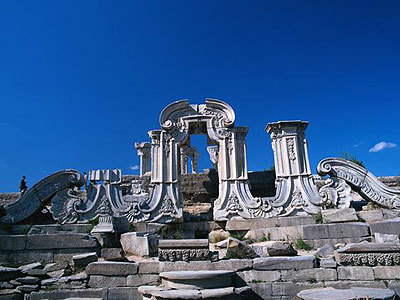The construction of the controversial replica of Yuanmingyuan park, also known as the Old Summer Palace, is confirmed as having been halted after an investigation discovered a misuse of the land.
|

|
|
The relic of Yuanmingyuan in Beijing [eastday.com] |
Website dzwww.com reported on Friday that the project was planned to begin construction in Hengdian county, eastern Zhejiang province in February last year. However, it was halted only two months later, after half of the 400 hectares of land the project planned to cover infringed upon the general land use plan of Hengdian, among which over 70 hectares were basic farmland.
Early in 2006, Xu Wenrong, chairman of Zhejiang Hengdian Foundation for Chinese Cultural Development, announced the plan to construct a direct copy of the Qing Dynasty (1644-1911) complex. The project was scheduled to finish in 2013.
But the decision immediately caused heated discussion on whether or not the royal gardens should be rebuilt.
One opposing voice is from the Ministry of Land and Resources, which said that the replica project hadn't been approved by related national authorities. The usage of the land also contravened the country's land supply policy.
According to the 'Limited Items List of Land Use' which was published in 2006, theme parks (including film cities) are unable to use arable land, while the land for the replica project was applied for in the name of ordinary urban construction land in order to use the farmland, said an official from the Shanghai Bureau of Land and Resources which directly manages the land of the area.
The land use plan in Dongyang city, where Hengdian county is located, was therefore frozen for half a year and the city government was urged to solve the problems. The replica project was then halted and related officials were punished.
Xu Wenrong, who was initially highly supportive of the construction despite opposition, says he will accept the decision.
According to a Xinhua report earlier this month, China is facing a large disparity between land supply and demand, and the area of arable land had shrunk by 4.6 million mu from the end of 2006 to 1.827 billion mu, slightly above the minimum of 1.8 billion mu (120 million hectares) set by the government.
|

|
|
A simulation image of the Yuanmingyuan [Xinhuanet.com] |
(CRI March 28, 2009)